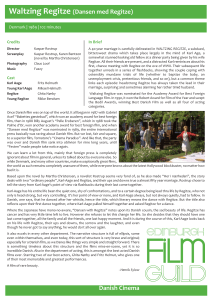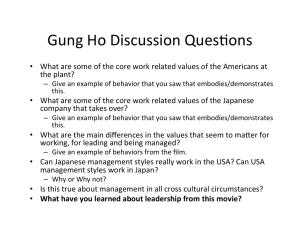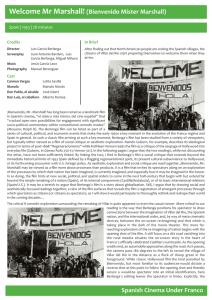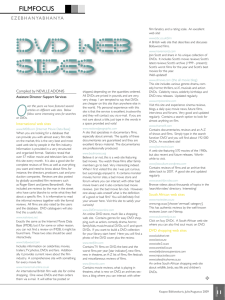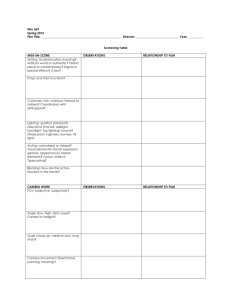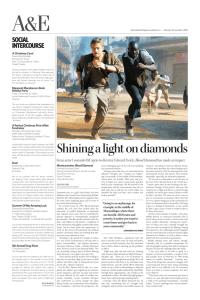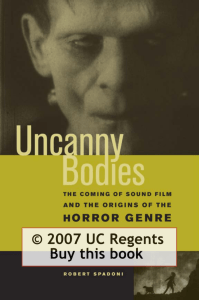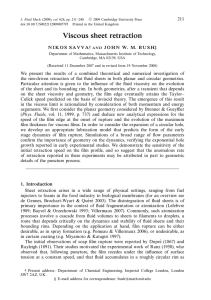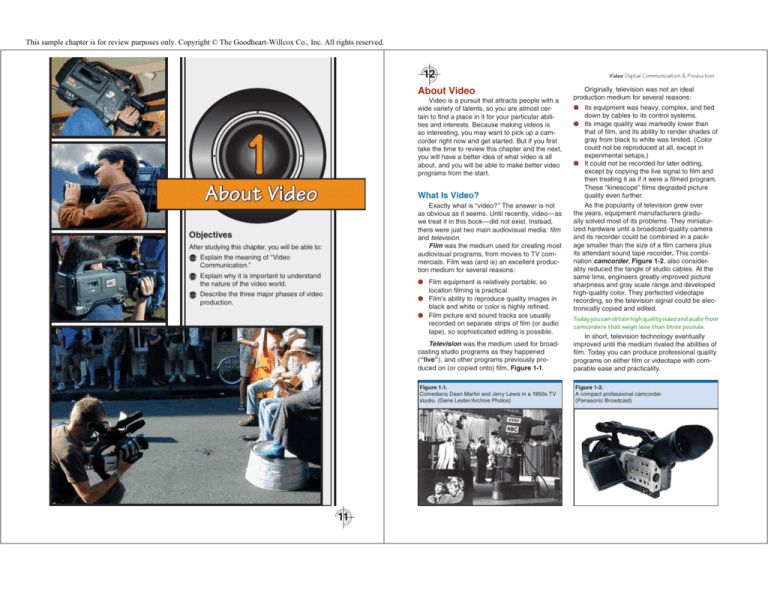
This sample chapter is for review purposes only. Copyright © The Goodheart-Willcox Co., Inc. All rights reserved.
12
About Video
Video is a pursuit that attracts people with a
wide variety of talents, so you are almost certain to find a place in it for your particular abilities and interests. Because making videos is
so interesting, you may want to pick up a camcorder right now and get started. But if you first
take the time to review this chapter and the next,
you will have a better idea of what video is all
about, and you will be able to make better video
programs from the start.
1
About Video
What Is Video?
Exactly what is “video?” The answer is not
as obvious as it seems. Until recently, video—as
we treat it in this book—did not exist. Instead,
there were just two main audiovisual media: film
and television.
Film was the medium used for creating most
audiovisual programs, from movies to TV commercials. Film was (and is) an excellent production medium for several reasons:
Objectives
After studying this chapter, you will be able to:
Explain the meaning of “Video
Communication.”
Explain why it is important to understand
the nature of the video world.
● Film equipment is relatively portable, so
location filming is practical.
● Film’s ability to reproduce quality images in
black and white or color is highly refined.
● Film picture and sound tracks are usually
recorded on separate strips of film (or audio
tape), so sophisticated editing is possible.
Describe the three major phases of video
production.
Television was the medium used for broadcasting studio programs as they happened
(“live”), and other programs previously produced on (or copied onto) film, Figure 1-1.
Figure 1-1.
Comedians Dean Martin and Jerry Lewis in a 1950s TV
studio. (Gene Lester/Archive Photos)
11
Video Digital Communication & Production
Originally, television was not an ideal
production medium for several reasons:
● Its equipment was heavy, complex, and tied
down by cables to its control systems.
● Its image quality was markedly lower than
that of film, and its ability to render shades of
gray from black to white was limited. (Color
could not be reproduced at all, except in
experimental setups.)
● It could not be recorded for later editing,
except by copying the live signal to film and
then treating it as if it were a filmed program.
These “kinescope” films degraded picture
quality even further.
As the popularity of television grew over
the years, equipment manufacturers gradually solved most of its problems. They miniaturized hardware until a broadcast-quality camera
and its recorder could be combined in a package smaller than the size of a film camera plus
its attendant sound tape recorder. This combination camcorder, Figure 1-2, also considerably reduced the tangle of studio cables. At the
same time, engineers greatly improved picture
sharpness and gray scale range and developed
high-quality color. They perfected videotape
recording, so the television signal could be electronically copied and edited.
Today you can obtain high quality video and audio from
camcorders that weigh less than three pounds.
In short, television technology eventually
improved until the medium rivaled the abilities of
film. Today you can produce professional quality
programs on either film or videotape with comparable ease and practicality.
Figure 1-2.
A compact professional camcorder.
(Panasonic Broadcast)
This sample chapter is for review purposes only. Copyright © The Goodheart-Willcox Co., Inc. All rights reserved.
13
CHAPTER 1 About Video
Nevertheless, the two media remain quite
different in many essential respects. Though
film has continued to evolve over the years, it is
still essentially the same medium. By contrast,
the electronic production technology that began
as “television” has changed so drastically that it
needs a name of its own.
That is why we now call it video.
Video versus Film
Some film makers think that video is less
desirable than their own medium in several ways:
● Video picture clarity is comparatively
coarse because its resolution is relatively
low, Figure 1-3.
● Video color sometimes lacks a certain richness and “snap” that is hard to describe but
easy to see in film. That is why some TV
commercials are shot on film, even though
they will be seen only on video.
● Until recently, video has offered less flexibility in sound editing. It is common for even
simple films to mix as many as eight or more
audio tracks. Sound editing has been more
cumbersome in video.
In other ways, however, film is less desirable
than video:
● Film is much more expensive to shoot and
process to a final composite positive print.
While small format video can cost as little as
two dollars an hour, finished film costs hundreds of times as much.
Figure 1-3.
At close range, the low resolution of video is obvious. (PBS)
● Film is less tolerant of different light levels,
so it must be supplied in several grades of
light sensitivity, to suit different conditions.
● Film sound is more cumbersome, since it is
almost always recorded on a separate tape
recorder.
● Film color balancing is time-consuming and
expensive.
● Film titles and effects, such as dissolves and
double exposures, cannot be added in real
time and evaluated on the edited working
copy. Instead, they must be created separately in the film laboratory.
● Film editing requires negative cutting, a
tedious and expensive extra step. Since the
original camera film is rarely used to create
an edited program, a negative cutter must
match it, frame-for-frame to the program’s
completed “work print,” before viewable
“release prints” can be made.
Many films now avoid these problems by digitizing
the original footage to create a “digital intermediate” (DI), completing postproduction in pure video
mode, and then converting the finished production
back to film for release.
14
almost limitless number of audio channels, multilayer sound tracks are now common.
Although film and video use different production techniques, they speak the same audiovisual “language.” If you master this language, you
can use it to communicate in either medium or in
any hybrid of both.
Types of Video Production
Today, people make a wide variety of video
programs ranging from five-second commercials
to thirteen-hour miniseries. These are distributed
by broadcast, cable, satellite TV and the Internet, and on discs played in schools, businesses,
and homes. Some videos are produced to entertain, to persuade, or to teach. Others capture a
family holiday, inventory a stamp collection, or
document a vacation.
Beyond the kinds of videos we think of as “programs” lie still other types, such as the specialized videography employed in areas as diverse as
medicine, industry, science, and law enforcement.
In fact, professional uses for video are expanding
in much the same way as computer applications. It
is probably safe to say that all but a few 21st Century careers will involve video in some way.
Video Digital Communication & Production
their colleagues on the production side. In particular, they need to understand how the video
medium communicates its message.
Not for Professionals Only
This book treats the art and craft of video
on a professional level. Making video programs
is usually a collaborative process carried on by
personnel working in organizations — that is, by
professionals.
However, you may not anticipate a career in
video production. Instead, you may want to master this medium purely for personal expression,
Figure 1-4. If so, you need not be concerned that
video is discussed here in a professional context.
Figure 1-4.
Consumer camcorders offer professional features.
Converging Technologies
Today, however, the arguments for and
against film or video are growing outdated as the
two media grow ever closer together. High-definition video, for example, is close to the visual
quality of film; and modern film stocks have
wider exposure ranges.
At the same time, visual hybrids are being created. For example, commercials that are shot on
film are then transferred immediately to tape. The
rest of the production process is pure video. In
other cases, videotape work prints are made, editing is completed, and then the film negative is cut
to match the tape. Finally, in many theatrical films,
the special effects are created electronically and
then transferred to film.
Working in video mode involves digitizing the film: scanning it frame-by-frame and converting it to a pattern
of tiny dots. Since a large computer can convert a
frame of film to a matrix of about 4,000 by 3,000
pixels (dots), the digitized images remain film-sharp.
Digital postproduction helps video as
well as film, especially in sound editing. Since
computerized editing software can handle an
Video Talents and Jobs
If you are considering a career in video, you
have a wide range of specialties to choose from.
If you like the story side of production, try
writing, directing, or editing. Though these crafts
involve different skills and techniques, they are
really all part of the same process. If you have
graphic talents, the specialties of art direction,
set and costume design, and makeup are vital
to sophisticated video production. You can also
create postproduction video graphics and titles.
If you are intrigued by the nuts and bolts of
production, then camera operation, lighting, and
audio recording are skills that command respect.
If you have technical aptitude, audio and
video engineering are challenging occupations.
If management is your aim, video producing and
production management require well-developed
skills in organization, personnel, and finance.
Every type of business expertise is employed
in running a video production unit or company. To
function effectively, corporate managers need to
know the fundamentals of video as thoroughly as
Like music or painting or photography or
cabinetmaking, video is an art in which “amateur” practitioners can and should develop
exactly the same skills that full-time professionals use to make their living in this medium.
Video Communication
You may become the best camera person
on your block, the finest sound recordist, or the
most talented makeup artist. But you still will not
know how to make a video unless you master
the art of video communication.
This book includes several chapters on video
communication, covering three broad topics:
the nature of the video world, the language
of video expression, and the construction of
video programs.
This sample chapter is for review purposes only. Copyright © The Goodheart-Willcox Co., Inc. All rights reserved.
Visual Literacy
Even if your career never involves producing video,
you spend considerable time consuming it — several
hours a day if you are a typical TV viewer. Video is the
most persuasive and powerful system ever invented
for delivering facts, ideas, and opinions. You may not
think video affects you all that much, but it does:
● It persuades you about what to buy and how to
vote.
● It explains who is important in the world and why.
● It teaches you how your community, your nation,
and your planet are working — and how they
should work if the world were an ideal place.
● It shows you what is fashionable, what is desirable, and what you are supposed to want in life.
● It models ways to love, fight, work, worship, and
dream.
Video does all this with a vividness and immediacy that make you feel that you are experiencing the
actual sights and sounds of the real thing.
In fact, you are not seeing the real thing. Instead,
you are presented with a sophisticated and carefully
contrived imitation of reality that the video makers
want you to accept. They may present the “reality”
that soap A is better then soap B. They may “prove”
that political candidate X is superior to candidate Y.
They may “demonstrate” that wolves are essential to
sound ecology (or, alternatively, that wolves are livestock killers that must be exterminated).
Even when they are not trying to sell you a product, a person, or an idea, makers of video programs
do not present reality; rather, they offer their own
versions of it. They cannot help doing this, because
even the most objective program simply cannot be
made without selecting and condensing reality. This
essential process imposes a certain point of view
on every video program, because the selection and
presentation of material reflect a set of standards
adopted by the program’s makers.
What does that mean to you as a viewer? If you
understand the techniques of video communication, you
can separate the information you are watching from
the methods used to organize and present it. At best,
you will be able to get past the artificial reality on your
screen to search for the actual reality beyond it.
At least, you will not be deceived by a medium
that looks real always but is real never.
This ability to understand how media work is
often called “visual literacy,” and the skills involved
are the subject of much of this book.
The Nature of the Video World
When you watch TV, you may think you are
looking at a picture of the actual world, but you are
not. The TV screen is a window that looks out on a
completely different universe — a strange cosmos
in which normal laws of space and time and gravity do not work at all. In the video universe:
Figure 1-5.
The outside of this door is a location.
16
15
CHAPTER 1 About Video
● An actor can open a door in London and
walk through it to Los Angeles.
● A car can turn a corner and jump forward a
week in time.
● An actor can fall ten stories onto concrete
and walk away unhurt.
The inside of the door is on a set.
Except during spectacular special effects,
most of the strange behavior of the video universe is quite invisible to the audience. Writers,
directors, designers, and editors understand
how to use the laws of the video world to fool the
viewer, Figure 1-5. These laws are so powerful that unless you understand them, you cannot
effectively tape a single scene or competently
edit two shots together.
Chapters 3 and 4 explain the rules and regulations of the video universe and show how to take
advantage of them to make effective programs.
The Language of Video Expression
Video communication uses a visual
language — a language with rules much like
those of a written language such as English
or Chinese.
For example:
●
●
●
●
An image is much like a single word.
A shot is like a complete sentence.
A scene is like a paragraph.
A sequence is like a chapter.
Unlike their written languages, the video languages
of England and China (and almost all other nations)
are the same. Video is a powerful social force, partly
because almost everyone on the planet understands the universal language of film and video.
At the basic level, video has a grammar, with
the equivalents of subjects and verbs and tenses.
On a more sophisticated level, video has its own
rhetoric — a wealth of techniques for creating
distinctive styles of expression. These techniques
include the management of composition and
camera movement, the creation of visual continuity, and the control of program rhythm and pace.
Like literary styles, powerful visual styles are recognizable. Just as a knowledgeable reader can tell
Dickens from Hemingway, an informed viewer can
identify a film by Fellini or Bergman or Scorcese.
The Construction of Video Programs
Video communication is like written communication in yet another way: it is not enough to write
a grammatically correct sentence or compose a
short paragraph. You must also be able to organize and develop a coherent story or essay — or
Video Digital Communication & Production
even a whole book. To make a professional video
program of any length, you have to design and
construct it as carefully as you would a piece of
professional writing.
Effective nonfiction programs, such as training films and documentaries, depend on logical subject organization, clear presentation, and
energetic pacing. Fiction, music, and performance videos also demand the skills of the artist and storyteller.
The shortest videos can be as hard to construct as
the longest. A 30-, 10- or even 5-second commercial
must organize and present its material with rigorous economy, so that it creates its intended effect.
Video Production
Video production falls into three broad
topics: preproduction, production, and
postproduction.
Preproduction
The preproduction phase includes everything you do before actual shooting begins.
Preproduction includes scripting (or storyboarding) the video, Figure 1-6, as well as scouting
locations, gathering cast and crew, and planning
production equipment and other requirements.
Preproduction may not seem as exciting as
shooting or as creative as editing, but experienced
professionals know that it is a mistake to shortchange the preproduction phase. Video programs
Figure 1-6.
A storyboard is a common alternative to a script.
This sample chapter is for review purposes only. Copyright © The Goodheart-Willcox Co., Inc. All rights reserved.
17
CHAPTER 1 About Video
Figure 1-7.
The storyboard is revised during preproduction.
are generally made in small, disconnected pieces.
Advance planning is essential to determine how
these pieces should fit together, Figure 1-7. Also,
in professional video production, time really is
money, so the more thoroughly you have planned
your shoot, the faster you can complete it. In creating professional programs, the preproduction
phase is often longer and more complicated than
the production phase.
Production
The production phase covers the actual shooting of the material that will become the video
program. In most productions, responsibility for
the visual character, or “look,” of the program is
shared by the director, videographer, and production designer. The director also guides the performers through their roles and ensures that the
program content is recorded from appropriate
points of view.
The director is usually supported by a production management staff, while the videographer
is assisted by a lighting director, sound recordist,
and key grip. (Grips are staff members who practice many of the technical crafts associated with
production.)
Working in close collaboration, the production people, technicians, and performers stage
and record the video footage that will become
the basis of the finished program, Figure 1-8.
Postproduction
At the end of the production phase, many
video newcomers are essentially finished.
“Shoot it and show it” might be their motto. But
for more experienced video makers, the postproduction phase is just as important as production,
and just as enjoyable.
When you finish shooting, you do not yet
have a video program, but only a collection of
footage. In postproduction you select the shots
you want to include, assemble them in order,
add music and sound effects to the audio, and
create titles and visual effects. Collectively, this
process is called editing, Figure 1-9. When practiced skillfully, editing is so creatively satisfying
that some video makers think of the production
18
phase as primarily a source of raw material for
postproduction.
The director Alfred Hitchcock said he did not find
the production phase especially interesting because
by the time it started, he had already finished making the entire movie in his head!
Video Digital Communication & Production
Development of the camcorder made it possible to blend
film and television techniques into a new kind of medium
known as “video.”
The Tip of the Iceberg
This introductory chapter has provided a
very brief overview of video communication and
production. The rest of this book is devoted to
the details of this rich and fascinating subject.
You do not have to master every chapter,
however, before you begin to shoot videos. Chapter 2 contains the essentials you need to make
short, simple programs. When you have completed that chapter, you should be able to achieve
satisfying results in beginning video production.
Chapter Review
Answer the following questions on a separate piece of paper. Do not write in this book.
1. The TV screen is a window that looks out on a completely different universe —the
universe.
2. A
combines the functions of a video camera and a sound recorder.
3. Film and video speak the same audiovisual “
.”
4. True or False? Amateur video makers do not need to develop the same skills
as professionals.
5. Video is a medium that looks real always, but is real
.
Technical Terms
Figure 1-8.
Shooting a documentary program. (Sue Stinson)
Figure 1-9.
Most of the postproduction phase is spent editing
the program. (JVC)
Camcorder: An appliance that both captures moving images (camera) and stores them on
tape or other media (recorder).
Digitize: To record images and sounds as numerical data, either directly in a camcorder or in the
process of importing them to a computer.
Film: An audiovisual medium that records images on transparent plastic strips by means of
photosensitive chemicals.
Live: Recorded and (usually) transmitted for display continuously and in real time.
Shoot: To record film or video; also, “a shoot” is an informal term for the production phase of a film
or video project.
Television: Studio-based, multicamera video that is often produced and transmitted “live.”
Video: An audiovisual medium that records on magnetic tape or other media by electronic means;
also, single-camera taped program creation in the manner of film production rather than studio
television.
Visual literacy: The ability to evaluate the content of visual media through an understanding of the
way in which it is recorded and presented.

